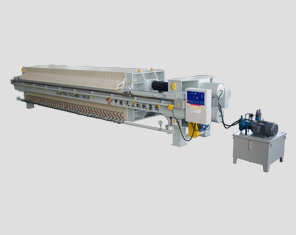Diaphragm filter presses have been widely used in mining, light industry, chemical industry and other industries because of the low moisture content of the filter cake and can complete automatic intermittent operation. The whole process of filter press requires the filtrate to be discharged out of the equipment. For the filter press, rapid drainage is the key to its work efficiency, especially in the feeding filtration stage, many filtrate needs to be quickly discharged, and the material has a great impact on the filter cloth and filter plate. If the cloth is damaged, the filtrate is often polluted at this stage. And the damage of the filter cloth will cause the filtrate to become dirty in the whole process of filtration, forming a lot of running materials, and the filtrate has a high solid content. To severe impact, manual labor intensity is high, and environmental pollution is severe.
Therefore, ensuring smooth and fast drainage of clean water, reducing inefficiency and ineffective filtration times has become an important way for filter presses to improve work efficiency, and this mainly depends on the integrity of the filter cloth, the drainage method and manual operation. Due to the damage of the filter cloth It is sudden and unpredictable, and the efficiency of manual operation fluctuates too much and lags behind. Therefore, the drainage method has become a controllable and easy-to-complete safeguard measure to ensure clear water drainage.
Conventional Drainage Method
The discharge method of the filter press is generally divided into open flow, dark tide and bright and dark tide together. Open flow refers to the method that the filtrate is directly discharged from the side of the filter plate. The method of consistent discharge in the channel. Most of the diaphragm filter presses used in mines will use the bright and dark tide to discharge together, or the open flow, and only under special circumstances will use the dark tide to discharge alone.
Open flow straight pipe
The open-flow straight discharge pipe may not be provided with corner holes, and the filtrate is directly discharged from the discharge surface → liquid outlet hole → integrated hole → open flow pipe. Valves are generally not installed when they are selected. In addition, in some occasions, they are not installed with straight pipes, but the integrated holes are directly punched down through the filter plate to form an open flow port, and the filtrate is received by using a liquid collector. Plates, such as some metal mines and some chemical industry filter presses.
Full dark tide drain
In the case of full under-tide drainage, most of the open flow ports are directly blocked, so that the filtrate is discharged from the under-tide tube composed of corner holes. This method is mostly used in fine chemicals, pharmaceuticals, hydrometallurgy and other situations where the filter cake needs to be washed. Coal is hardly used in the occupation.

Related Industry Knowledge
- Daily maintenance and maintenance of vertical presses
- Application scope and characteristics of soy sauce press
- Principle of diatomite filter and maintenance guide of filter lubrication system
- The understanding of the nominal flow of the filter and its application
- Diaphragm filter press hydraulic device adopts double cylinder and screw extension structure
- Rice wine press by maintenance and preventive measures
- Daily maintenance and maintenance of plate and frame filter press
- Features of automatic filter press
- Diatomite filter operation method and application
- Working principle and characteristics of stainless steel press
- Which method should be used to maintain the filter plate of the filter press?
- What are the factors that affect the filtering time of filter equipment?
- How to indicate the type of filter cloth?
- Welding Distortion Control and Prevention of Diaphragm Filter Press Frame
- Talking about the effect of the hydraulic system of the filter press on the whole system
- What are the key factors in the disposal of drilling fluids in a diaphragm filter press?
- How to use bag filter device in filter equipment
- What are the reasons for the lack of pressure when the special equipment for stainless steel filter press cannot be pressed?
- Advantages and disadvantages of choosing diaphragm pump or screw pump for filter press
- The difference between plate and frame filter press and diaphragm filter press


